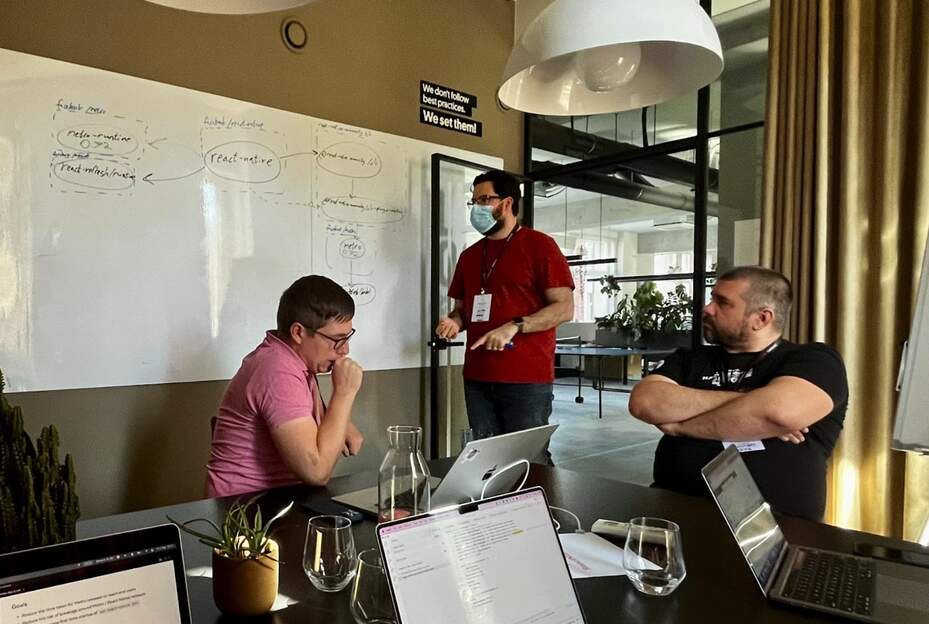The annual summits, just like everything else out there, got a big hit due to the pandemic. The world of technology still had an upper hand in the sense that they could still innovate remotely but there is a certain charm with real in-person summits that all developers missed during the tough times globally. After many online events, React decided to have their annual core contributor summit in September.
The event also coincided with the React Native EU Conference which is for contributors across the continent. The aim was to brainstorm futuristic ways of developing applications. The workshops included topics like Codegen and TypeScript Support, New Architecture Library Migration, Monorepo, etc.
What is React Native?
React Native is a platform that incorporates a JavaScript library with native development. Native development indicates that the same set of codebase can be used across both iOS and Android. This makes the codebase native. A
react native app development service revolves around either bootstrapping a mobile application or updating existing apps on both Android as well as iOS.
React ensures this by using the core with native components like View, Text and Image. These components map directly to the platform’s native UI building blocks. This makes it very easy for developers to manage both versions of the same app without having to hassle separately.
Key Takeaways from the Global Event
This year’s event also involved addressing multiple concerns raised by the developers’ community throughout the year. Apart from resolving the ongoing concerns, the core team also came out with some cool new features and functionalities that will change the way apps are made.
The two-day
summit highlighted some really interesting aspects of the platform. Here are some of the most promising ones that you can take away.
Codegen & TypeScript Support
Codegen is touted to be the most fundamental aspect of the new architecture. The extended support for it was evident when React added support for generic code that started from TypeScript specs instead of Flow. The new contributors to Codegen emphasized two main aspects – supporting new types and improving auto-linking for iOS.
Running a unit test for Codegen was encountering some serious concerns that the new team addressed straight away. After careful understanding of the code execution flow, the team was able to come up with the first prototype that dealt with the aforementioned concern. The new solution recognized string union types in TypeScript that is now seen as a huge move for the future.
Many developers, iOS ones especially, complained about auto-linking not working at instances when both the libraries and the app were living together in Monorepo. While the solution for the same issue on Android was presented, the iOS community still missed it. With the help of an Umbrella Task and a Hacktoberfest, the solution finally arrived for iOS developers too.
New Architecture Library Migration
New architecture, as is the case with all updates for all platforms, was the one that created the most hype. The migration of the library into the new architecture is always a tough execution. Powerful brainstorming and in-person feedback with the contributors brought a lot of clarity. Apart from migrating a large number of libraries to the new architecture, this session of the event also initiated migration for community packages like react-native-document-picker, react-native-store-view and react-native-orientation.
Monorepo
React Native is one of the most downloaded packages on NPM. The whole process of releasing a new version was twofold. First was to expand the continuous integration infrastructure that would support the Monorepo by adding
Verdaccio to the testing infrastructure. Second step was to rename and add scopes to several packages.
Metro Web
Metro since its launch has been a fundamental JavaScript Bundler. The focus in this summit regarding Metro was to improve its feature set that would improve working with web use cases. Two key points to ponder upon to improve the feature set for Metro’s web use cases were -adopting the “exports” specifications and working with web and bundler ecosystem.
Metro Simplified
Metro as a bundler plays a pivotal role with every new update. The releases of the newer versions are never trivial for React. To improve the workflow of Metro, all the dependencies between the key tools like React Native, Metro and CLI were reconsidered. The exchange of views from both Metro team and CLI team helped them understand the workflow of one another better.
Conclusion
The sole purpose for these kinds of events is to ensure that all valid concerns are resolved and all rational voices are heard. The pandemic surely slowed the evolution of platforms like React Native but the unique proposition it has of being a common thread between two rival application hosts makes it a frontrunner again. React is one of Meta’s best developer centric products. It offers something no other platform does and yet makes sure all valid opinions are acknowledged annually. This year’s event was driven more by resolution than innovation, but the vast participation indicates that the years to come are pretty bright for the React community.

